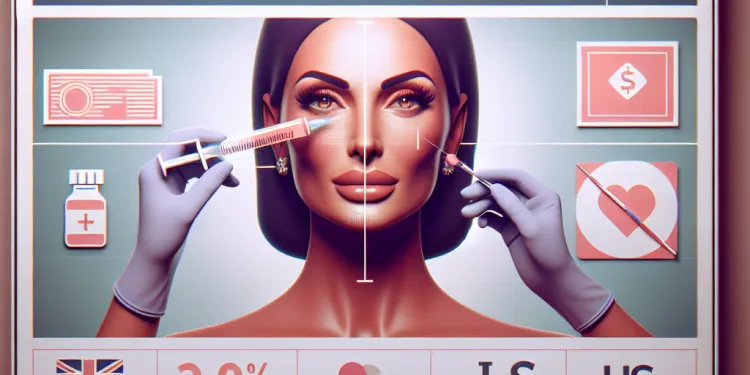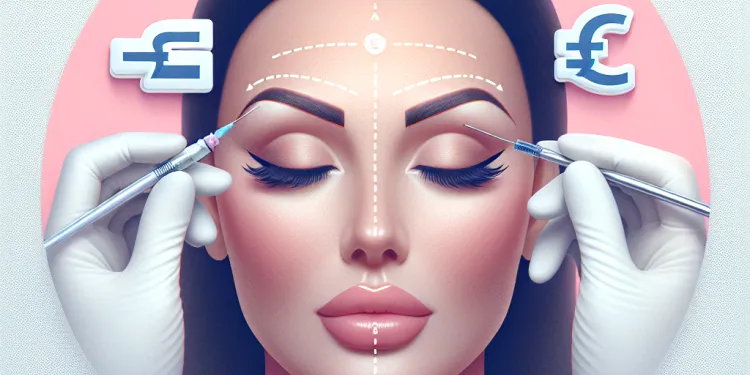
Find Help
More Items From Ergsy search
-

Can Botox spread to other parts of the body?
Relevance: 100%
-

Can impetigo spread to other parts of my body?
Relevance: 78%
-

Can testicular cancer spread to other parts of the body?
Relevance: 72%
-

Can bowel cancer spread to other parts of the body?
Relevance: 72%
-

Is Botox safe?
Relevance: 70%
-

What is Botox?
Relevance: 69%
-

What are the side effects of Botox?
Relevance: 69%
-

How does Botox work?
Relevance: 68%
-

Does Botox hurt?
Relevance: 65%
-

Is Botox safe?
Relevance: 65%
-

Are there any long-term effects of using Botox?
Relevance: 65%
-

Is Botox vegan?
Relevance: 65%
-

What is Botox used for?
Relevance: 64%
-

Is Botox treatment expensive?
Relevance: 64%
-

Can I get Botulism from Botox Treatments?
Relevance: 64%
-

Can Botox cause serious health issues?
Relevance: 64%
-

What are the side effects of Botox?
Relevance: 62%
-

What is Botox made from?
Relevance: 62%
-

Who can administer Botox?
Relevance: 62%
-

Can Botox lift my eyebrows?
Relevance: 61%
-

What are the common uses of Botox?
Relevance: 60%
-

What areas can be treated with Botox?
Relevance: 60%
-

How long does Botox last?
Relevance: 60%
-

How often should I get Botox treatments?
Relevance: 60%
-

Can Botox be used for migraines?
Relevance: 60%
-

Can Botox help with excessive sweating?
Relevance: 60%
-

Can anyone get Botox treatments?
Relevance: 59%
-

Can I get Botox while pregnant?
Relevance: 59%
-

How much does Botox cost?
Relevance: 59%
-

How does Botox work if it's related to botulism toxin?
Relevance: 59%
-

Does Botox injection hurt?
Relevance: 59%
-

How should I prepare for a Botox appointment?
Relevance: 58%
-

How long do the effects of Botox last?
Relevance: 58%
-

How long has Botox been used in medicine?
Relevance: 57%
-

What should I do if I experience side effects after a Botox injection?
Relevance: 56%
-

Can Botox be used for treating conditions other than wrinkles?
Relevance: 56%
-

How soon will I see results from Botox?
Relevance: 55%
-

What precautions should I take before getting Botox?
Relevance: 55%
-

How should I choose a provider for Botox treatments?
Relevance: 53%
-

How is viral meningitis spread?
Relevance: 49%
Understanding Botox
Botox is a popular cosmetic treatment that involves injecting a toxin produced by the bacterium Clostridium botulinum into the skin. This treatment is widely used to reduce the appearance of facial wrinkles, and it can also have medical applications such as treating muscle spasms, excessive sweating, and certain bladder and neurological conditions. In the UK, as in many other places, Botox has become a commonplace procedure, praised for its ability to temporarily paralyse muscle activity in the targeted area.
The Mechanism of Action
Botox works by blocking the release of acetylcholine at the neuromuscular junction. This prevents muscles from receiving signals to contract, leading to a temporary weakening or paralysis of those muscles. It is most frequently injected into facial muscles, where its effects can last anywhere from 3 to 6 months.
Concerns About Spread
A common concern among potential patients is whether Botox can spread to other parts of the body. In a typical and correctly-administered procedure, the risk of Botox spreading significantly beyond the injection site is minimal. However, there have been reports, albeit rare, of Botox spreading to other areas and causing complications.
Scientific Evidence
Studies have indicated that while Botox can migrate slightly from the injection site, this usually occurs within a small area and does not typically affect other distant parts of the body. A potential spread is more concerning with higher doses, which is why it's crucial to have Botox administered by a qualified and experienced professional who can accurately control dosage and injection sites.
Possible Side Effects
When Botox does migrate, whether due to improper administration or dosage, possible side effects can include drooping of the eyelid or eyebrow if injected near the upper face. More severe systemic effects, such as difficulty swallowing or breathing, may indicate a more extensive spread, though this is extremely rare and generally linked to excessive doses.
Professional Guidelines and Safety
The key to minimizing any risk of spread or adverse effects lies in choosing a reputable and medically-trained practitioner. The UK's regulatory body, the General Medical Council, alongside other organisations like the British Association of Cosmetic Nurses, provides guidelines ensuring the safe application of Botox. Patients are advised to research practitioners thoroughly and discuss any concerns prior to treatment.
Conclusion
For most individuals, Botox is a safe and effective treatment when administered correctly. While the risk of spreading to other parts of the body cannot be entirely ruled out, it remains significantly low, especially when conducted by trained professionals. As with any medical treatment, potential patients should be well-informed and consult with their healthcare provider to discuss all possible risks and benefits.
What is Botox?
Botox is a special medicine. Doctors use it to make your skin look smoother. They do this by putting Botox into the skin with a small needle. People often get Botox to help with wrinkles on their face. Botox can also help with health problems like muscle twitching and too much sweating. It makes the muscles stop moving for a little while.
How Does Botox Work?
Botox works by stopping messages from your nerves that tell muscles to move. When doctors put Botox in the muscles, the muscles do not move as much. This makes wrinkles look smoother. The effects of Botox usually last about 3 to 6 months.
Can Botox Move to Other Parts of the Body?
Some people worry that Botox might move to other parts of the body. But if Botox is done the right way, it usually stays where it was put. Sometimes it can move a little, but this is rare. It is important to have a good doctor do the Botox.
What Do Studies Say?
Studies show Botox can move a tiny bit from where it was put. But it usually stays close by and does not go to far away parts of the body. If too much Botox is used, it might move more. This is why it is very important to have an expert doctor put in the right amount.
What Are the Side Effects?
If Botox moves, it might cause problems. For example, your eyelid or eyebrow might droop. These problems can happen if Botox is near your eye. Serious problems, like trouble breathing, are very rare. They usually happen if too much Botox is used.
How to Stay Safe with Botox
To stay safe, go to a doctor who knows a lot about Botox. In the UK, good doctors follow rules about how to use Botox safely. You should learn about the doctor and ask questions before getting Botox.
Wrapping Up
Botox is safe for most people if done by a skilled doctor. The chance of it moving around the body is low. But just like other treatments, it's good to know all the facts. Talking to your doctor will help you know the risks and benefits of Botox.
Frequently Asked Questions
Useful Links
- Ergsy carfully checks the information in the videos we provide here.
- Videos shown by Youtube after a video has completed, have NOT been reviewed by ERGSY.
- To view, click the arrow in centre of video.
- Most of the videos you find here will have subtitles and/or closed captions available.
- You may need to turn these on, and choose your preferred language.
- Go to the video you'd like to watch.
- If closed captions (CC) are available, settings will be visible on the bottom right of the video player.
- To turn on Captions, click settings .
- To turn off Captions, click settings again.
More Items From Ergsy search
-

Can Botox spread to other parts of the body?
Relevance: 100%
-

Can impetigo spread to other parts of my body?
Relevance: 78%
-

Can testicular cancer spread to other parts of the body?
Relevance: 72%
-

Can bowel cancer spread to other parts of the body?
Relevance: 72%
-

Is Botox safe?
Relevance: 70%
-

What is Botox?
Relevance: 69%
-

What are the side effects of Botox?
Relevance: 69%
-

How does Botox work?
Relevance: 68%
-

Does Botox hurt?
Relevance: 65%
-

Is Botox safe?
Relevance: 65%
-

Are there any long-term effects of using Botox?
Relevance: 65%
-

Is Botox vegan?
Relevance: 65%
-

What is Botox used for?
Relevance: 64%
-

Is Botox treatment expensive?
Relevance: 64%
-

Can I get Botulism from Botox Treatments?
Relevance: 64%
-

Can Botox cause serious health issues?
Relevance: 64%
-

What are the side effects of Botox?
Relevance: 62%
-

What is Botox made from?
Relevance: 62%
-

Who can administer Botox?
Relevance: 62%
-

Can Botox lift my eyebrows?
Relevance: 61%
-

What are the common uses of Botox?
Relevance: 60%
-

What areas can be treated with Botox?
Relevance: 60%
-

How long does Botox last?
Relevance: 60%
-

How often should I get Botox treatments?
Relevance: 60%
-

Can Botox be used for migraines?
Relevance: 60%
-

Can Botox help with excessive sweating?
Relevance: 60%
-

Can anyone get Botox treatments?
Relevance: 59%
-

Can I get Botox while pregnant?
Relevance: 59%
-

How much does Botox cost?
Relevance: 59%
-

How does Botox work if it's related to botulism toxin?
Relevance: 59%
-

Does Botox injection hurt?
Relevance: 59%
-

How should I prepare for a Botox appointment?
Relevance: 58%
-

How long do the effects of Botox last?
Relevance: 58%
-

How long has Botox been used in medicine?
Relevance: 57%
-

What should I do if I experience side effects after a Botox injection?
Relevance: 56%
-

Can Botox be used for treating conditions other than wrinkles?
Relevance: 56%
-

How soon will I see results from Botox?
Relevance: 55%
-

What precautions should I take before getting Botox?
Relevance: 55%
-

How should I choose a provider for Botox treatments?
Relevance: 53%
-

How is viral meningitis spread?
Relevance: 49%


